April Wildlife
Spring in Florida: Snowbirds head back north, residential roads fill with lawn care vehicles, bird song competes with riding mowers -- and tiny wildlife greets my camera again at our strip malls and post office.
1.
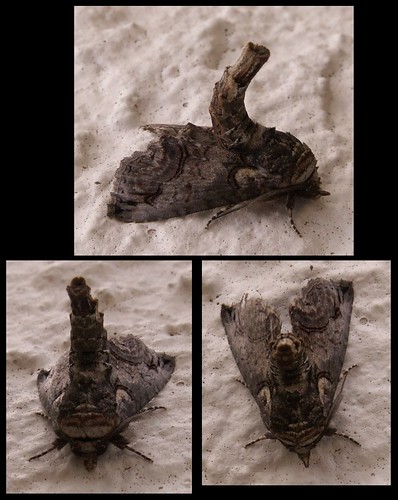
Large view
Genus Paectes. Photographed at our local post office on April 4, 2011. Thanks to William Donald Newton at Bugguide for the ID. According to Bugguide, this genus contains 12 species.
This is the second moth species I've seen that tilts its abdomen up. The other was a male Mournful Sphinx moth I'd photographed in 2005.
2.
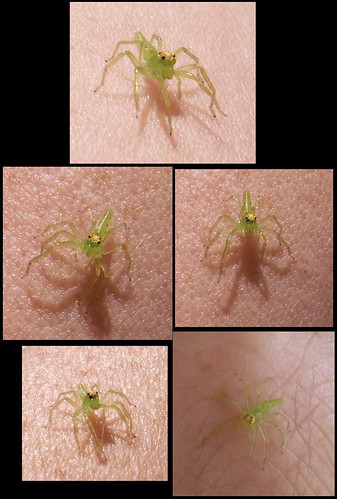
Large view
Magnolia Green Jumper (Lyssomanes viridis). (Best viewed large.)
This little one (body about 5mm long) dropped onto my hand during a windy day in the park on April 16. My first thought was an immature green lynx spider, but then I saw the eyes on the downloaded shot. Those big ones in front are typical of Salticidae (jumping spiders).
This species ranges from North Carolina to Florida and west to Texas. BugGuide also reports several images sent from Virginia.
3.
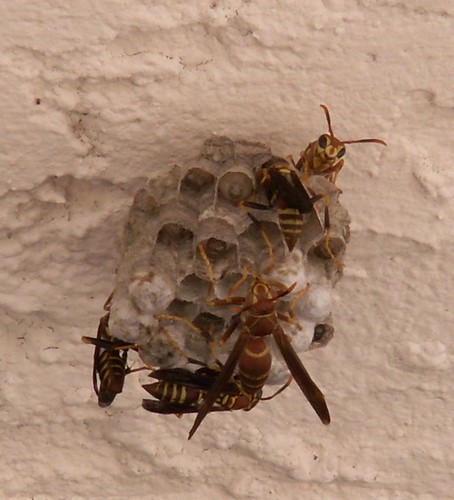
Wasps in the Polistes genus (paper wasps). "Probably from Greek polistes ... 'founder of a city,'" according to Bugguide.
These individuals were building their nest at the local strip mall. Photographed on April 20.
On Earth Day (April 22) I spotted a couple of moth species high up on the post office wall:
4.

Merry Melipotis moth, Melipotis jucunda, Family Erebidae. Thanks to Randy Hardy at Bugguide for the ID. Estimated body length of this individual is about one inch.
"Two or three broods in New Jersey, multiple generations in Deep South with mature caterpillars throughout growing season," says Bugguide.
I also photographed this species in 2007.
5.

Southern Emerald moth, Synchlora frondaria, Family Geometridae. Ranges throughout "southern USA; Central and South America; Greater & Lesser Antilles," according to Bugguide.
Thanks go again to Randy Hardy for the ID. I had photographed a member of this species in 2007, but that individual had been considerably larger than this one: an estimated 25mm wingspan then, versus about 15mm now. I wasn't sure I had seen members of the same species. Bugguide places the average size at 15mm.
Also on Earth Day, and also at the post office, I found this antlion:
6-7.
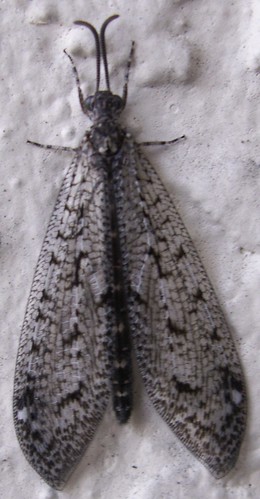
Large view
Close-up of head and thorax:

Large view
Order Neuroptera (Antlions, Lacewings and Allies), Family Myrmeleontidae (Antlions). Body is about two inches long.
Antlions are beneficial insects that eat insect pests. Larvae are also called "doodlebugs," due to the tracks they leave in sand. The larvae of most antlion species dig shallow sand pits to trap prey. See this University of Florida page for more info, and this page on how to rear your own.
Not-so-tiny wildlife:
8.
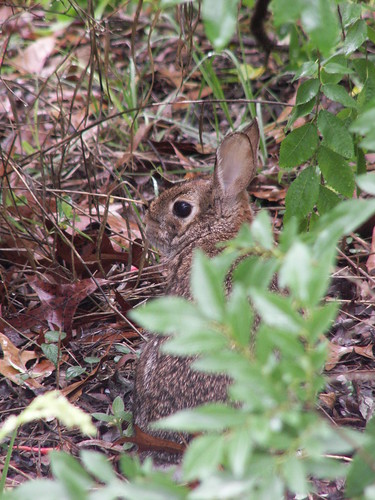
Large view
I had been reading on our front porch when this bunny hopped into view. Storms had created a neighborhood power outage on April 5; otherwise I wouldn't have taken advantage of natural light and seen this little one.
And overhead...
9.
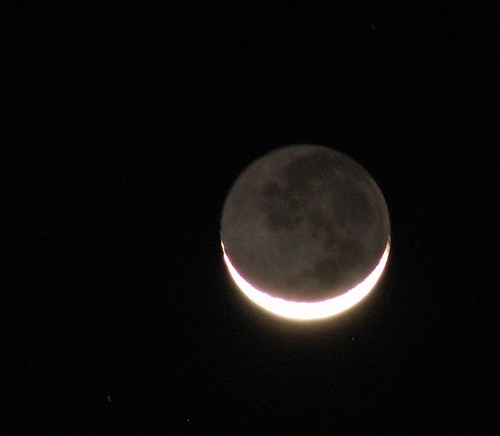
Taken at 8:53 p.m. Eastern Time, April 5. The Moon is 59 hours 21 minutes old and 5 percent of full. This might be my best earthshine shot to date.
Keith Cooley explains that Earthshine "is caused by sunlight that reflects off the Earth onto the Moon's night side. Under the earthshine, the Moon's outline and its dark features can be seen, even though only a thin crescent is bright. We see the Moon because of reflected sunlight (the Moon does not generate its own light). At times, however, the dark part of the Moon glows."
Elissa Malcohn's Deviations and Other Journeys 
Promote Your Page Too

Vol. 1, Deviations: Covenant (2nd Ed.), Vol. 2, Deviations: Appetite, Vol. 3, Deviations: Destiny, Vol. 4, Deviations: Bloodlines, Vol. 5, Deviations: TelZodo
Free downloads at the Deviations website, Smashwords, and Manybooks.

Proud participant, Operation E-Book Drop (provides free e-books to personnel serving overseas. Logo from the imagination and graphic artistry of K.A. M'Lady & P.M. Dittman); Books For Soldiers (ships books and more to deployed military members of the U.. armed forces); and Shadow Forest Authors (a fellowship of authors and supporters for charity, with a focus on literacy).

This work is licensed under a Creative Commons Attribution-NonCommercial-ShareAlike 2.5 License.
1.

Large view
Genus Paectes. Photographed at our local post office on April 4, 2011. Thanks to William Donald Newton at Bugguide for the ID. According to Bugguide, this genus contains 12 species.
This is the second moth species I've seen that tilts its abdomen up. The other was a male Mournful Sphinx moth I'd photographed in 2005.
2.

Large view
Magnolia Green Jumper (Lyssomanes viridis). (Best viewed large.)
This little one (body about 5mm long) dropped onto my hand during a windy day in the park on April 16. My first thought was an immature green lynx spider, but then I saw the eyes on the downloaded shot. Those big ones in front are typical of Salticidae (jumping spiders).
This species ranges from North Carolina to Florida and west to Texas. BugGuide also reports several images sent from Virginia.
3.

Wasps in the Polistes genus (paper wasps). "Probably from Greek polistes ... 'founder of a city,'" according to Bugguide.
These individuals were building their nest at the local strip mall. Photographed on April 20.
On Earth Day (April 22) I spotted a couple of moth species high up on the post office wall:
4.

Merry Melipotis moth, Melipotis jucunda, Family Erebidae. Thanks to Randy Hardy at Bugguide for the ID. Estimated body length of this individual is about one inch.
"Two or three broods in New Jersey, multiple generations in Deep South with mature caterpillars throughout growing season," says Bugguide.
I also photographed this species in 2007.
5.

Southern Emerald moth, Synchlora frondaria, Family Geometridae. Ranges throughout "southern USA; Central and South America; Greater & Lesser Antilles," according to Bugguide.
Thanks go again to Randy Hardy for the ID. I had photographed a member of this species in 2007, but that individual had been considerably larger than this one: an estimated 25mm wingspan then, versus about 15mm now. I wasn't sure I had seen members of the same species. Bugguide places the average size at 15mm.
Also on Earth Day, and also at the post office, I found this antlion:
6-7.

Large view
Close-up of head and thorax:

Large view
Order Neuroptera (Antlions, Lacewings and Allies), Family Myrmeleontidae (Antlions). Body is about two inches long.
Antlions are beneficial insects that eat insect pests. Larvae are also called "doodlebugs," due to the tracks they leave in sand. The larvae of most antlion species dig shallow sand pits to trap prey. See this University of Florida page for more info, and this page on how to rear your own.
Not-so-tiny wildlife:
8.

Large view
I had been reading on our front porch when this bunny hopped into view. Storms had created a neighborhood power outage on April 5; otherwise I wouldn't have taken advantage of natural light and seen this little one.
And overhead...
9.

Taken at 8:53 p.m. Eastern Time, April 5. The Moon is 59 hours 21 minutes old and 5 percent of full. This might be my best earthshine shot to date.
Keith Cooley explains that Earthshine "is caused by sunlight that reflects off the Earth onto the Moon's night side. Under the earthshine, the Moon's outline and its dark features can be seen, even though only a thin crescent is bright. We see the Moon because of reflected sunlight (the Moon does not generate its own light). At times, however, the dark part of the Moon glows."


Free downloads at the Deviations website, Smashwords, and Manybooks.
Proud participant, Operation E-Book Drop (provides free e-books to personnel serving overseas. Logo from the imagination and graphic artistry of K.A. M'Lady & P.M. Dittman); Books For Soldiers (ships books and more to deployed military members of the U.. armed forces); and Shadow Forest Authors (a fellowship of authors and supporters for charity, with a focus on literacy).











0 Comments:
Post a Comment
<< Home